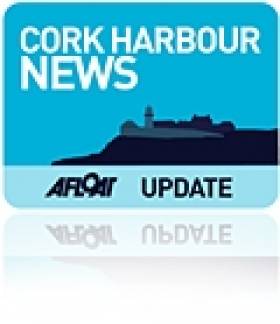Displaying items by tag: Moorings
'Unauthorised' Harbour Moorings to be Removed
The Port of Cork intends to remove all unauthorised or illegibly marked moorings in Cork harbour this winter and has written to harbour users about the removal which will start next month.
The Port Company recently completed a detailed survey of all moorings within Cork Harbour. A number of unauthorised and illegibly marked moorings have been identified in the course of the survey. The Port says it is the responsibility of the mooring holder to ensure that their mooring is in the correct position and is clearly marked at all times with the correct mooring number. All unauthorised or illegibly marked moorings will be removed over the coming months commencing on the 1st day of November 2010.
The Port has asked Royal Cork Yacht Club to bring the matter, affecting all harbour users, to the attention of its members according to a post on the club website.
The post also says that all boats are requested to obey the speed limits in various parts of the harbour, particularly on their way to the new pontoon in the city. Boats travelling at excessive speed make life very difficult for other harbour users, particularly the members of the rowing clubs on the river.
Irish Coastal Marinas, Pontoons & Jetties
IRELAND'S MARINAS, PONTOONS AND JETTIES - 60 AND COUNTING! (SUMMER 2013)

South-West Coast
Kilrush Marina – 170 berths. Kilrush, Co. Clare. Tel: 065 905 2072, email: [email protected]
Fenit Marina – 130 berths (to be extended). Tralee and Fenit Harbour Commissioners, Harbour Office, Fenit, Tralee, Co. Kerry. Tel: 066 713 6231, email: [email protected]
Dingle Marina – 80 berths. Dingle, Co. Kerry. Tel: 066 915 1629, email: [email protected]
Cahersiveen Marina – 93 berths. ACARD Ltd., 'The Old Barracks', Bridge Street, Cahersiveen, Co. Kerry. Tel: 066 947 2777, email: [email protected]
South Coast
Lawrence Cove Marina – 50 berths. Bere Island, Co. Cork. Tel: 027 75044, email: [email protected]
Kinsale Marina – 270 berths. Kinsale Yacht Club & Marina, Kinsale, Co. Cork. Tel: 021 477 3433, email: [email protected]
Castlepark Marina – 150 berths. Kinsale, Co. Cork. Tel: 021 477 4959, email: [email protected]
Royal Cork Yacht Club Marina – 200 berths. Royal Cork Yacht Club, Crosshaven, Co. Cork. Tel: 021 483 1023, email: [email protected]
East Ferry Marina – 100 berths. East Ferry, Cobh, Co. Cork.
Crosshaven Boatyard Marina – 120 berths. Crosshaven Boatyard Co. Ltd., Crosshaven, Co. Cork. Tel: 021 483 1161, email: [email protected]
Salve Marina – 57 berths. Crosshaven, Co. Cork. Tel: 021 483 1145, email: [email protected]
South-East Coast
Arklow Marina – 72 berths. North Quay, Arklow. Tel: 0402 39901/32610, email: [email protected]
Kilmore Quay Marina – 55 berths. Harbour Office, Kilmore Quay, Wexford. Tel: 053 91299 or 087 900 1037.
Three Sisters Marina, New Ross – 66 berths. Tel: 086 388 9652 or 051 421284, email: [email protected]. Also New Ross Town Council, The Tholsel, New Ross, Co. Wexford. Tel: 051 421284, email:[email protected]
East Coast/Dublin Area
Malahide Marina – 350 berths. Malahide Marina Centre, Malahide, Co. Dublin. Tel: 01 845 4129, email: [email protected]
Howth Yacht Club Marina – 270 berths (to be extended). Harbour Road, Howth, Co. Dublin. Tel: 01 839 2777, email: [email protected]
Dublin City Moorings – 30 berths. Dublin Docklands Development Authority, 52–55 Sir John Rogerson's Quay, Docklands, Dublin 2. Tel: 01 818 3300, email: [email protected]
Poolbeg Marina – 100 berths. Poolbeg Yacht, Boat Club & Marina, South Bank, Pigeon House Road, Ringsend, Dublin 4. Tel: 01 668 9983, email: [email protected]
Dun Laoghaire Marina – Over 800 berths. Harbour Road, Dun Laoghaire, Co. Dublin. Tel: 01 2020 040, email: [email protected]
Greystones Marina - 100 berth facility. [email protected] Call: +353 (0)86 2718161
North and North-East Coasts
Lough Swilly Marina – 200 berths, more after extension. Marina Office, Fahan, Inishowen, Co. Donegal. Tel: 074 936 0008, email: [email protected]
Foyle Pontoon, Derry – 50 berths. Foyle Pontoon, Londonderry Port, Port Road, Lisahally, Co Londonderry BT47 6FL, N. Ireland. Tel: 0044 28 7186 0313 (24 hours), email: [email protected]
Seatons Marina – 70 berths. Drumslade Road, Coleraine, BT52 1SE, N. Ireland. Tel: 028 7083 2086, email: [email protected]
Coleraine Marina – 60 berths. Cloonavin, 66 Portstewart Road, Coleraine BT52 1EY, N. Ireland. Tel: 028 7034 4768, email: [email protected]
Portrush Harbour – 100 berths. Portrush, Coleraine, N. Ireland. Harbour Master, Mr Richard McKay, tel: 028 7082 2307 or on VHF channel 12. Further information from Victor Freeman on tel: 028 7034 7234.
Ballycastle Marina – 74 berths. Contact: John Morton, 14 Bayview Road, Ballycastle BT54 6BT, N. Ireland. Tel: 028 2076 8525
Rathlin Island – 30 berths. Ballycastle, N. Ireland. Contact Moyle District Council, Sheskburn House, 7 Mary Street, Ballycastle BT54 6QH, N. Ireland. Tel: 028 2076 2225, email: [email protected]
Glenarm Marina – 40 berths. Glenarm Harbour, Glenarm BT44 0EA, Co Antrim, N. Ireland. Tel: 028 2884 1285
Carrickfergus Marina – 280 berths. 3 Rodgers Quay, Carrickfergus BT38 8BE, N. Ireland. Tel: 0044 28 933 66666
Bangor Marina – 500 berths. Bangor Marina, Quay Street, Bangor, Co. Down BT20 5ED, N. Ireland. Tel: 0044 28 9145 3297, email: [email protected] or [email protected]
Portaferry Marina – 15 visitor berths. 11 The Strand, Portaferry, Co. Down BT22 1PF, N. Ireland. Tel: 0044 28 4272 9598, email: [email protected]
Phennick Cove Marina – 55 berths. 19 Quay Street, Ardglass, Co Down BT30 7SA, N. Ireland. Tel: 0044 28 4484 2332, email: [email protected]
Carlingford Marina – 300 berths. 6 Carlingford Marina, North Commans, Carlingford, Co Louth. Tel: 042 937 3073, email: [email protected]
Proposed New Marinas (as at March 2009)
Bray
Cobh
Courtown
Dungarvan
Galway
Killybegs
Schull
Skerries
Union Hall




























































